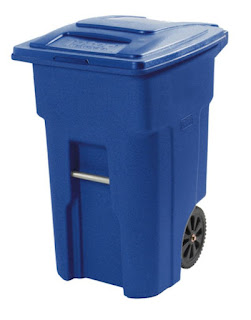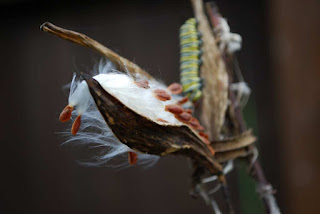Except for maybe thy neighbor's Italian cypress trees? Probably no harm in coveting them, because everybody else does!!
:-)
I ranked Texas wax myrtle as my favorite landscape plant for Centerpointe because of its intended-size versatility on small subdivision lots, because it grows so fast, and because of its hardiness (it's native, drought tolerant, and almost cannot be killed by neglect).
However, I did note that wax myrtle is more of a utilitarian tree / shrub than a real showpiece. If you want a real "bling" show-stopper tree on a small lot, your choice might be Italian cypress. I have gotten more compliments on our increasingly-majestic Italian cypress trees than on any other element of our landscape design. They grow UP instead of OUT, which makes them particularly well-suited for tight spaces.
And they also grow UP very quickly:
 |
| This is what three of our current six looked like the day they went into the ground (I say "three of our current six" because I fully intend to plant more in the future). You can see underground utility lines marked on the ground in orange paint. Our yard, like just about every yard in Centerpointe, has a utility easement in the back yard. Anything planted in such an easement is planted at the homeowner's risk, which was my motivation for making sure that these trees were planted on either side of the existing lines, rather than right on top of them (such a strategy is not a guarantee of no future disturbance, but it might work to my advantage in helping to preserve the trees at some point in the future if the utility companies need to access these lines... bear in mind that if the lines DO need to be accessed, it will likely be many years into the future, so even if I lose a few trees and shrubs, we'll get to enjoy them in the meantime). I have a separate post detailing how to deal with utility easements. |
 |
| Look at how much the little ones in particular have grown in such a short time. They looked like toothpicks when I first put them in. |
 |
| When is the last time these guys have likely seen any TLC?! Screengrab of a Presidio street scene from Googlemaps. |
 |
| Another example of Italian cypress life in the desert, the land where lawns do not exist. |
Part of my purpose in writing these posts is to demonstrate that cost is not an excuse for not installing landscaping. Again, we bought our cypress trees in the autumn, when the nearby Houston Garden Center has its annual 70% off sale. That means we paid about $30 for each of the smaller (six-foot) cypresses, and $100 apiece for our two largest (12-foot) ones. And you can see how nice the $30 ones look just 18 months after installation.
Thirty bucks?! How could you possibly do better than thirty bucks apiece for starter trees that quickly become majestic?!
This is another reason why I'm not concerned about the future potential for loss if the utility companies need to dig in our backyard easement. I paid so little for most of this stuff and I get to enjoy it between now and whenever. If some of it is eventually killed by utility work, I'm not going to lose a big financial investment.
And not only that, the little ones can be taken home in the back of a minivan or pick-up truck - you don't even have to pay for delivery if you're DIY-ing. The big ones may be a bit more of a challenge...
 |
| For about $20, you can rent a trailer from that U-haul place that's a stone's throw from Centerpointe. We did this because we simultaneously were hauling large Texas wax myrtles. |
 |
| Check and verify that they still have trailers for rent. I believe this is where we rented the one we used. |
 |
| Very tasteful integration of a privacy screen, from http://www.norcaltreeandstump.com/before-and-after-3.php |
The other local horticultural outlets that I enjoy are as follows:
- Maas Nursery. It's top-notch in terms of quality and is not a "big box" style establishment, so you'll pay for that quality, but wow, what an experience just to walk around in the place. I tend to buy a lot of smaller specialty items at Maas. They have good prices and unbeatable selection on hanging baskets and patio plants, for instance (often $15 - $25 apiece for really large, unusual centerpiece-type plants that are difficult to find in big-box stores).
- Caldwell's Nursery. This is the best one I've seen overall in greater Houston, but you have to drive to Rosenberg to visit it. They specialize in bamboo, about which I'll post at a later date.
:-)
 |
| For sale to good homes needing wonderful landscaping. |











































